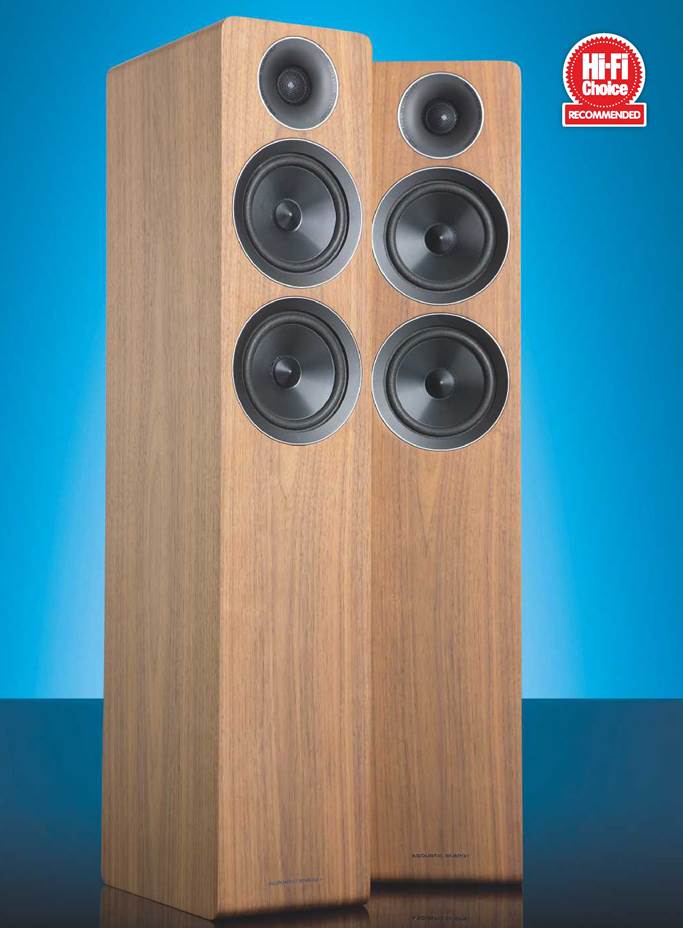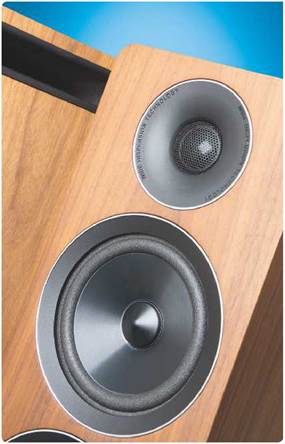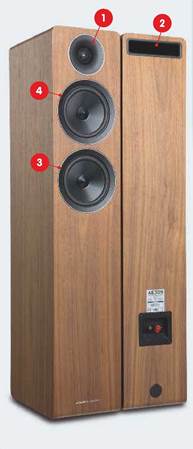Acoustic Energy AE309 Review – Running in the family
Ceramic membranes are known for being very hard, expensive, and difficult to drive. This is not the case with Acoustic Energy AE309; for 1300 euros, you get this miracle material – and a lot of sound.
The product policy of AE follows the best British understatement: The fact that the new AE309 floorstanding speaker is equipped with ceramic drivers is neither highlighted by the typical whitish matte color nor can the fine differences from the 100 series be recognized from a distance, except for the slightly larger dimensions and driver diameters.

In fact, the unobtrusive floorstanding speaker contains really interesting, almost high-end technology. Foremost among these are the two 13 cm cone drivers, designed as mid-bass drivers. Their membranes consist of a black anodized aluminum-ceramic sandwich that combines the internal damping of the elemental metal with the high hardness and speed of the ceramic. Driven by small but very long-throw voice coils designed with overhang technology, conical dust caps ensure that the cones behave neutrally and free of resonances even into the presence range.

The 25mm tweeter sports Wide Dispersion Technology for greater coverage
Soft foam surrounds, which give the drivers a slightly retro charm, provide suspension without significant external restoring forces, which is not necessary given the hardness of the membranes. Thus, the upper 13 cm driver can run up to 2500 Hz, while the lower one is gradually faded out from 300 Hz and only supports the bass and fundamental tone.
Focused Highs
The bundling already starting above 2000 Hz due to the hard cone was taken into account in the design of the tweeter unit: A relatively large 28 mm aluminum dome with a steep waveguide is intended to harmonize the radiation pattern in the transition and thus make the speaker also suitable for far-field, which in this size class – barely 90 centimeters tall – almost qualifies as a unique selling point.
The speaker technician rubs his eyes in amazement when he hears about the very good sensitivity (83 dB) with high minimum impedance (exclusively 6 ohms) and respectable deep bass. Achieving all this in such a compact box is akin to squaring the circle and reveals a level of development know-how that is almost never invested in the entry-level segment. The unspectacular but very solid and neatly real-wood-veneered cabinet shows that you get an above-average amount of speaker for the money here despite the compact dimensions.
Homogeneous and Stable Imaging
In the listening test, the small AE309 surprised with a large-volume deep bass foundation that maybe didn’t explore the last Hertz of Stanley Clarke’s “Justice Grooves” and presented the upper bass rather slim, but did hammer a sense of right timing and clean punch into the room. Even at distances of over three meters, it managed the feat of homogeneous and stable imaging, as one is used to from the best near-field monitors.
The “Children’s March” from Reference Recordings is considered in the editorial team not only as a litmus test for the variety of timbres in orchestra and ear but also reveals weaknesses in the imaging of individual instruments. The AE309 projected a very realistic and homogeneous concert hall in which each individual voice had its air to breathe and a realistic acoustic environment.
Outstanding was the transparency and clear resolution of all instruments in the tonal mixtures, which always seemed natural and unobtrusive. Sure, the spatial imaging was not blown up effectfully and brass instruments sounded a touch too tame, but for this charm of a relaxed playing style, where you can lean back as a listener and enjoy the music with a glass of red wine in hand, high-enders usually pay many times the price of the AE.
With AC/DC’s “Thunderstruck,” the AE reached its dynamic limits relatively late and added a punchy deep bass to its rather slim fundamental character. A speaker that also presents difficult recordings enjoyably and could become an insider tip among small floorstanding speakers due to its friendliness towards room, amplifier, and spouse.
Insights

1) 25mm aluminium dome tweeter
2) Bass reflex port
3) 130mm bass driver
4) 130mm mid/ bass driver
Specs
PRODUCT Acoustic Energy AE309
ORIGIN UK/China
TYPE 2.5-way floorstanding loudspeaker
WEIGHT 22kg
DIMENSIONS (WxHxD) 175 x 900 x 280mm
FEATURES
• 1x 25mm aluminium dome tweeter
• 1x 130mm mid/bass driver
• 1x 130mm bass driver
• Quoted sensitivity: 89dB/1W/1m (6ohm)
DISTRIBUTOR Acoustic Energy Loudspeakers Ltd.
TELEPHONE 01285 654432
WEBSITE acoustic-energy.co.uk
HOW IT COMPARES
Q Acoustics’ Concept 40 floorstander is a direct rival, and a formidable one at that. It is a touch larger and more substantial looking, but it doesn’t have a gutsier sound.
Q&A
James Luce
Brand manager, Acoustic Energy

DP: Who is the AE309 aimed at?
JL: Customers upgrading from the entry level wanting better sound, build and refinement. Someone wanting a compact, clean and unobtrusive floorstander offering a very balanced, neutral presentation of their music that can let rip and play loud and low when required. It has been one of our lengthier projects, as we developed completely new drive units for this range, every part of the speaker aside from the crossover cup is new.
It took 18 months of listening and tuning. Taking this time has given us far more control than is usually possible at lower price points. With every component being a bespoke design for this range it means we can make the speaker work mechanically as seamlessly as possible before we even begin screwing it together and fine tuning the sound. This makes a big difference to the quality of the end product.
What’s the story behind the drivers?
We’ve worked with aluminium drive units since we were founded in 1987, and have been refining them ever since. In this particular incarnation we’ve flattened the cone profile slightly to help soften the edge break-up, which can sometimes cause a harsher sound in metal drive units. We’ve also used a substantial roll surround on the new tweeter to lower the base resonant frequency as much as possible. Combined, these factors enable a far more even sound across the operating band of the drive units and smoother crossover region.
What about cabinet construction?
Much has been done internally to keep resonances controlled. New for the 300 Series is a simplified version of the constrained layer rubber damping from our Reference Series used in the bracing, helping to minimise harmful panel resonances. Bracing positions have been placed to segment the large panel surfaces unequally, avoiding resonance build up from the cabinet at a particular frequency. We also mass load the base to aid stability and provide additional damping.
Verdict
A surprisingly large-sounding and finely detailed speaker with very cohesive, holographic soundstage. Excellent imaging even at larger listening distances, combines monitor qualities with a relaxed music enjoyment for leaning back.






